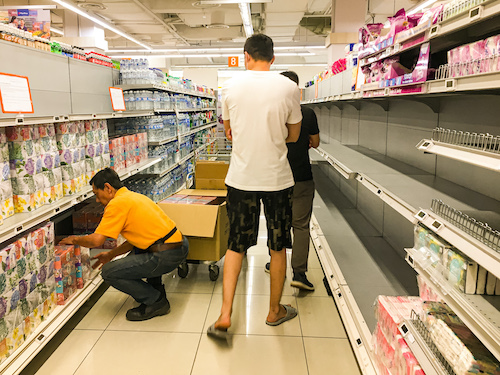Over the weekend, Michigan Attorney General Dana Nessel announced that her office received 75 complaints of retailers gouging coronavirus-panicked consumers on the price of basic necessities:
Stores in Farmington Hills, Dearborn, Ann Arbor and Allendale have been accused of jacking up the price of hand sanitizers, face masks, and rice and lentils by up to 900%. In one case, the Allendale store was allegedly selling face masks that would normally sell for $3 apiece for $6 to $10 each. Another store had increased the price of a small bottle of hand sanitizer from $1 to $10 and another was selling bigger bottles of hand sanitizer for $20, $40 or $60 a bottle. One market allegedly boosted the price of rice and lentils by 60%.
The Detroit Free Press reported that Michigan Gov. Gretchen Whitmer “signed an executive order Sunday making it a misdemeanor, with a maximum penalty of $500, for a retailer to raise prices of essential items that are more than 20% higher than what the business was selling the products for as of March 9, 2020.” The order went into effect at 9 a.m. Monday and will remain in place until April 13.
Now, as surely as panic follows crisis, we’ll hear arguments from economists explaining why price gouging is an efficient way to allocate needed goods and services and how the price system will rebalance supply and demand.
Here’s the rationale in a 2017 Econlog discussion by David Henderson:
We economists point out, as I did here, that the higher prices during emergencies attract resources–water, plywood, etc.–from other parts of the country. Think about who those people are who are supplying the resources. The obvious point is that they probably wouldn’t do it if they were not allowed to charge higher-than-normal prices. The more-subtle point is that they don’t have to worry about lost good will from future customers because many of them are engaged in one-time transactions. The guy who thinks to buy a lot of cases of water in advance and then sell them to others may not even be in the water business. He’s simply trying to make a buck by doing something that buyers show by their actions is very valuable.
Henderson goes on to say that “by allowing price gouging, we get, to some extent, the best of both worlds. We get the traditional merchants like Wal-Mart, who worry about reputation, stocking certain supplies in advance and not raising prices. We also get the fringe, one-time suppliers, bringing in more supplies in response to the higher prices they can charge.”
As an exercise in economic thinking, this is correct, as far as it goes. But it leaves out the repugnant, nauseating gut reaction to being taken advantage of in a time of real crisis. If you want to convince people that the market economy is a place where people voluntarily trade for mutual benefit, now is not the time to make callous arguments based on economic efficiency. Here’s one of many examples of what happened in the wake of Hurricane Harvey in 2017:
One station sold gas for a whopping $20 a gallon. A hotel reportedly charged guests more than twice the normal rate. One business sold bottles of water for a staggering $99 per case — more than 10 times some of the prices seen online.
But we’ve got a bigger problem than price gouging, and that’s the panic-driven hoarding that’s been underway for weeks. President Donald Trump is right on this: “You don’t have to buy so much. Take it easy. Just relax.” We live in a country with such a superabundance of food that until recently it seemed that our biggest problem was how to cut down on the stupendous waste and excess that we couldn’t consume. This is true for both supermarkets and restaurants. At the same time, there’s an entire industry designed to salvage some of this food and redirect it to charities and food banks.
According to the U.S. Department of Agriculture, an estimated 30 to 40 percent of the food supply is wasted. The USDA reported, “This estimate, based on estimates from USDA’s Economic Research Service of 31 percent food loss at the retail and consumer levels, corresponded to approximately 133 billion pounds and $161 billion worth of food in 2010.”
We did not have these panicky shortages until too many people began taking way more than they need. It’s a move to regain control over a situation that seems completely out of control.
Dimitrios Tsivrikos, lecturer in consumer and business psychology at University College London, said toilet paper has become an “icon” of mass panic:
“In times of uncertainty, people enter a panic zone that makes them irrational and completely neurotic,” he said in a phone call. “In other disaster conditions like a flood, we can prepare because we know how many supplies we need, but we have a virus now we know nothing about.”
“When you enter a supermarket, you’re looking for value and high volumes,” he added, noting that people are drawn to the large packaging that toilet paper comes in when they are looking to regain a sense of control.
By all accounts, we face a coronavirus pandemic with huge risks and even bigger unknowns in the weeks and months ahead. The most powerful thing that we all can do is refrain from irrational behavior, like brawling in stores and scooping up water, and guns and ammo, before your neighbor gets to it. That is sure to unravel the delicate social fabric of cooperation and solidarity that no attorney general or consumer protection enforcer can legislate.
Gregory of Nyssa, the fourth-century theologian, understood the human person not as an isolated individual but theologically as a whole, a humanity in communion. That does not mean we subsume our personality into some vague oversoul; he’s simply pointing to our shared social nature. “To say there are ‘many human beings’ is a common abuse of language,” he wrote. “Granted there is a plurality of those who share in the same human nature … but in all of them, humanity is one.”
Let’s not lose sight of that.
(Photo credit: cattan2011. This photo has been cropped. CC BY 2.0.)

